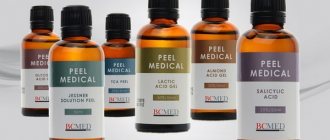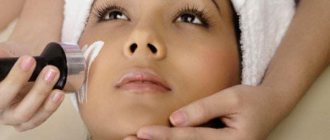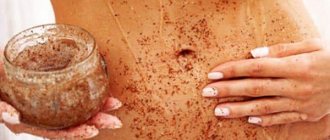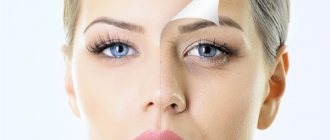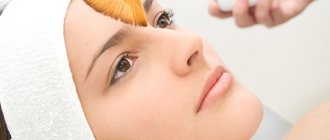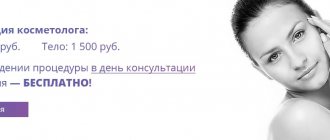Jessner Peel Composition
The classic Jessner peel contains equal parts of salicylic and lactic acids and alcohol-based resorcinol:
- lactic acid - 14%;
- salicylic acid - 14%;
- resorcinol - 14%.
This is exactly the set of ingredients that Dr. Max Jessner proposed for his colleagues. This happened in the middle of the last century, and already in 1993 the composition was supplemented and improved by the president of PCA skin, Margeret Ansira.
Modified versions of the exfoliant do not contain resorcinol, are less toxic and are less likely to cause allergies. Therefore, women with dark or sensitive skin can use them.
To obtain a stronger exfoliating effect, the concentration of lactic acid in some preparations can be increased to 20% versus the standard 14%. Ethanol is used as a solvent.
Properties of lactic acid
The substance is an integral part of the epithelium, and when it gets on its surface in small quantities, it creates an acidic environment. This helps suppress the proliferation of pathogenic microorganisms and helps get rid of acne. In addition, lactic acid, an alpha hydroxy acid, has a mild exfoliating and whitening effect on the skin, moisturizes and stimulates the production of elastin and collagen.
Properties of salicylic acid
Salicylic acid is considered an excellent antiseptic. It quickly and actively softens the top layer of skin, improves exfoliation, dries and accelerates tissue regeneration.
The component is highly soluble in oil, so it is used to reduce sebum secretion and fight acne. The substance cleanses oily skin, frees pores from contents and narrows them, dries out inflammation, and eliminates itching.
Action of resorcinol
In medicine, resorcinol is used as a disinfectant and tanning agent in the treatment of skin diseases. The component has a pronounced antimicrobial effect and enhances the work of acids.
Thanks to the antiseptic, skin inflammation and irritation rarely occurs after Jessner peeling. Chemical burns heal quickly and completely, leaving no scars.
Jessner Peel with Hydroquinone
Exfoliants with a similar component are modified products and have a pronounced brightening and smoothing effect. Hydroquinone is considered a good antioxidant, but if used in excess, it can trigger the growth of cancer cells. Doctors warn that if quinol is applied too often, the opposite effect is possible - the skin will acquire a grayish tint and become covered with spots.
In Russia and European countries, cosmetics containing hydroquinone are prohibited. In the USA, the substance is approved for use in a concentration of no more than 2%.
Products with hydroquinone are suitable for women with thick, dense skin. On thin and sensitive epithelium, drugs can cause severe irritation.
Types of Jessner peeling
In most cases, Jessner peeling is used as a superficial procedure, but can also be used for a more serious - medium - effect. To understand the difference between them, let's look at each option in more detail:
- Superficial exfoliation. One layer of the drug is applied to the skin. The procedure is performed to moisturize the epidermis, smooth out the relief and reduce pores, or as a preparatory measure for a deeper effect. After exfoliation, slight peeling is observed for 2–3 days.
- Median exfoliation. The skin is covered with two or more layers of solution. In this case, the drug penetrates the entire level of the epidermis without reaching the basement membrane. The recovery period takes 5–6 days with more severe peeling. The method copes with expression wrinkles, post-acne, scars and pigmentation.
Sometimes peeling is carried out in 4-5 stages and is called deep. It is performed only in exceptional cases, since the procedure is quite traumatic and produces a pronounced vascular reaction with the effect of surface coagulation. Skin treated with this method will heal for at least 2 weeks.
The optimal type of exfoliation is selected individually by the cosmetologist and depends on the type of defects and the patient’s skin.
Indications for use
Jessner's chemical peel can solve many problems. This is why the Hollywood version is so loved by cosmetologists and patients.
Indications for the procedure:
- expression and age wrinkles;
- dark spots;
- acne;
- photoaging;
- dry and dehydrated skin;
- dermatological diseases (hyperkeratosis, rosacea);
- post-acne, scars and cicatrices;
- stretch marks and stretch marks;
- preparation for other cosmetic procedures (plasty, deep exfoliation, mesotherapy).
Exfoliation with acids not only rejuvenates the skin, but also acts as an excellent prevention of aging.
Contraindications for the procedure
Chemical exfoliation, even the lightest and most non-aggressive one, is a serious cosmetic procedure that has its limitations, and you should be aware of them.
Contraindications for Jessner peel:
- individual intolerance to exfoliant components;
- inflammation and trauma to the skin (rashes, abrasions, scratches, cracks);
- exacerbation of herpes;
- pregnancy and lactation;
- infectious processes occurring with fever;
- oncology.
It is not recommended to carry out the procedure for demodicosis - peeling can provoke a relapse, and the patient will have to undergo treatment for a long time.
A temporary contraindication to acid exfoliation should be the season of the year - exfoliation should not be carried out during periods of high solar activity. The best time for the procedure is from October to March.
In case of serious diseases of the liver, kidneys or heart, only superficial peeling should be used. In this case, the limiting point is resorcinol. With each additional layer, its toxic effect on the body increases, which can adversely affect people with chronic pathologies.
Technique
Chemical exfoliation is a quick and, at first glance, simple manipulation, but it requires the cosmetologist to have a lot of experience and good knowledge of the procedure protocol with a certain composition.
Step-by-step implementation of the Jessner peel:
- The session begins with cleansing the skin with special products with a neutral pH. After a minute, the composition is washed off and the face is treated with alcohol.
- The exfoliant is shaken and quickly applied with a cotton swab, starting from the forehead to the chin.
- After the peeling composition, according to the protocol, Aglycolic cream, Retises Forte or another drug and sunscreen are applied to the skin. This concludes the procedure.
If it is necessary to cover the skin in several layers, this is done 2-3 minutes after each previous one.
Please note that exfoliant is usually not washed off from the face in a beauty salon. You will remove it at home 6 to 12 hours after the procedure.
And one more important point - you should not leave the salon with uncovered peeling, that is, the face after exfoliation should be treated with special preparations.
Video: peeling procedure
C Infusion Peel
NEW DERMAQUEST!
Lifting effect: “Facelift without surgery”
Powerful Antioxidant Peeling with Vitamin C, Hyaluronic Acid, Sweet Orange Stem Cells - Gently exfoliates and starts the process of Renewal of Epidermal Cells and Dermal Matrix structures.
The stabilized form of Vitamin C in the peeling strengthens damaged skin collagen and increases the biosynthesis of collagen, elastin and glycosaminoglycans. All-season and atraumatic, has a powerful antioxidant effect - actively restores skin cells after UV irradiation - prevention of photoaging .
It has a pronounced lifting effect: “Facelift without surgery . Peeling of choice from the moment the process of age-related skin changes begins: smoothes expression lines, evens out skin tone and texture; moisturizes, tones and gives the skin radiance.
Order a cost estimate for DermaQuest procedures
INDICATIONS:
Correction of age-related changes. Photoaging. The skin of smokers and skin with a gray tint with insufficient lymphatic drainage function and microcirculation. Hyperkeratosis. Off-season, can be carried out in the summer.
COMPLEXES OF THERAPEUTIC ACTION:
- Ascorbic Acid (15%) - Powerful antioxidant. Activates the production of your own collagen, restores cells damaged by ultraviolet radiation.
- Hyaluronic acid (10%) - in micronized form - supplies moisture to the deep layers of the skin.
- Lactic acid (10%) - AHA - Keratolytic. Restores skin barriers, moisturizes and soothes. — Ideal for thin and sensitive skin.
- Phytic acid (5%) - Keratolytic with a lightening effect (tyrosinase inhibitor), prevents the appearance of age spots.
- Sweet Orange stem cells – activation of type IV collagen production. Evens out the relief and restores the extracellular matrix.
- Complex of Bamboo silicate, pea extract and glucosamine (Derm SRC PF) - increases the synthesis of collagen, elastin and hyaluronic acid - “Face lift without surgery” (according to the manufacturer).
More details about the ingredients
RECOMMENDATIONS FOR USE:
New Formula: Pura and Activator.
For professional use only. Detailed instructions for use are available after registration.
We invite cosmetologists to take part in the Webinar “Enriched DermaQuest Peels”, participants receive a Certificate and the opportunity to perform DermaQuest Peels in professional practice.
Post-peeling care
After washing your face after the session, treat your skin with a healing cream or apply a post-peeling mask. This will relieve irritation, reduce the risk of complications and speed up healing.
For restorative care, products with hyaluronic acid, aloe, and chamomile are suitable. Be sure to use sunscreen during the peeling course.
During the rehabilitation period it is not recommended:
- use decorative cosmetics;
- visit the solarium, bathhouse and sauna;
- sweat actively;
- stay in the cold for a long time.
Under no circumstances should you peel off any crusts that have formed from the skin, otherwise spots will remain on your face after healing. This will entail deeper peeling or other cosmetic procedures.
It is advisable to schedule your exfoliation session for the middle of the week so that peak exfoliation occurs on the weekend. Then you can calmly take care of yourself without scaring anyone with peeling skin.
Side effects
At its core, chemical peeling is a regular burn with all the ensuing consequences. The process of epidermal rejection can be accompanied by various negative reactions:
- redness of the treated surface;
- swelling;
- darkening of the skin;
- increased sensitivity of renewed tissues.
If hygiene rules are not followed, infection with bacterial microflora may occur, followed by inflammation and suppuration. In this case, you will need to use external ointments with antibiotics: Baneocin, Levomekol.
Cost of the procedure in salons
The cost of Hollywood peeling largely depends on the region, the status of the clinic, the qualifications of doctors and the drugs used. On average, the price of one procedure varies from 3,000 to 7,000 rubles.
Large clinics usually use more expensive Jessner solutions from Martinex or MedicControlPeel (MCP). Cosmetologists who perform at-home treatments use drugs at a lower cost. Accordingly, the cost of the procedure is lower.
Protocol
Impact on the skin at a mid-level requires preparation, so a month before the procedure you must stop using a scrub and not sunbathe. For two weeks, you should not visit the pool, bathhouse or sauna, and when going outside, use a cream with a high SPF level. It is advisable to take a course of multivitamins containing omega fatty acids, these substances will help tissue restoration.
“When preparing, it is necessary to do a test for an allergic reaction,” notes Olga Degtyareva. “And to increase efficiency, we can recommend light superficial peeling, ultrasonic facial cleansing, biorevitalization or mesotherapy.”
During the procedure, the skin is cleaned, degreased and an active solution is applied. After five minutes, if necessary, apply a second layer, then a third. At this moment, tingling and burning may be felt. At the final stage, a soothing mask is applied.
The active substance should remain on the face for five to six hours, so wash off the composition at home. It is important to follow the cosmetologist’s recommendations for further care in order to speed up the regeneration process and make the recovery period more comfortable.
Jessner peeling cannot be done at home - the risk of “overdoing” using a mixture of acids is too great and you will get a severe burn. The procedure cannot be performed in the summer, when the sun is active, which increases the risk of age spots and worsening existing pigmentation. The exception is superficial Jessner peeling - it can be done in the summer, while medium and deep peeling is performed only in autumn or winter.
Popular brands and prices
When going for a peel, be sure to ask what product the dermatologist works with. The Salicylicpeel JS solution from Martinex has very good reviews. It contains 10% lactic acid, 14% each of salicylic acid and resorcinol.
Other brands are no less popular:
- MedicControlPeel (MSP) Russia. The drug is not cheap; for 30 ml you will have to pay 4800 rubles;
- Allura (Allure) Esthetics USA— 2480 rub. for 30 ml;
- MedPeel USA - 2600 rub. for 30 ml;
- Mediderma (Mediderma) Spain - 7130 rub. for 60 ml;
- PCA Skin USA — 2840 rub. for 30 ml.
Recently, Kaitlin and ONmacabim from Israel have been gaining popularity . A tube of their product costs about 3,000 rubles.
Retinoic or Jessner peel – which is better?
Jessner or retinoic peeling, which is better is decided by the cosmetologist, depending on the condition of the client’s skin. There are options for combining procedures indicated for caring for problematic epidermis. After using retinoids, many patients report a burning sensation during the session. Allergic reactions may occur - itching, burning, redness. Side effects after Jessner peeling are less common, despite the more aggressive composition. It is recommended to perform complex aesthetic problems. But the retinoic procedure has a more pronounced effect.
The retinoic procedure is based on the action of synthesized analogues of vitamin A. After applying the composition, a yellow film forms on the face, which is washed off no earlier than after 8-10 hours. Prescribed after reaching 30-35 years of age to improve the appearance of the face and neck décolleté. It is highly effective and you can admire the results for 4 months. It is recommended to undergo the procedure from October to March. Under the influence of acid, the skin loses its barrier functions to ultraviolet radiation.
Warning! After retinoic peeling, products with an SPF factor prescribed by a cosmetologist must be used.
Retinoic peeling helps:
- cope with sagging, loss of elasticity;
- eliminate traces of acne and other dermatological diseases;
- smooth out shallow scars;
- refresh color;
- normalize the synthesis of sebaceous secretions;
- whiten deep pigmentation;
- reduce wrinkles around the eyes and mouth;
- restore moisture levels.
Jessner peel at home
If it is impossible to visit the salon or if you want to save money, the procedure can be performed at home.
It is recommended to purchase peeling solutions on the company’s website or buy them in any online store specializing in professional cosmetics. No prescription is required.
Usually, a protocol is attached to the Jessner solution, which describes step by step how to do peeling, but it assumes some knowledge and experience in practical cosmetology.
If you still decide to exfoliate yourself, consult a specialist first and find out how to apply the product correctly and how long to keep it on. And, most importantly, only superficial exfoliation can be done at home. The middle and deep options should be entrusted to a specialist.
Reviews of Jessner peeling from cosmetologists
Cosmetologists consider this peeling to be one of the best. A reasonable price, a minimum of contraindications and a good anti-aging effect - all this puts the procedure on a par with mesotherapy and plastic surgery. Even superficial Jessner is more effective than almond, enzyme or amber exfoliation.
Jessner peeling - expert review
“This is not a procedure where you can come to a beauty salon and “order” it at your own discretion,” notes Olga Degtyareva. — Here you need to consult with a cosmetologist, who may suggest performing this particular type of peeling. And perhaps he will advise replacing it with other procedures, for example, biorevitalization or mesotherapy. They are often performed as a preparation for Jessner peeling, but sometimes it turns out that mesotherapy is quite enough to achieve the required result, and the peeling itself is no longer necessary. Therefore, first of all, you need to consult a cosmetologist.”
Answers on questions
How many procedures are needed per course to achieve maximum effect and how often are they performed?
The duration of the course depends primarily on the composition of the exfoliant. The more aggressive the solution, the fewer procedures will be needed to achieve the effect, but the interval between them will increase.
For example, for sensitive skin, 4 sessions with a break of 7–10 days will be enough. To smooth out wrinkles or scars, you will need a more concentrated composition. In this case, only 2 sessions are performed with an interval of 2 weeks.
Can it be done during pregnancy?
In itself, skin exfoliation as a cosmetic way to improve appearance does not pose a threat to mother and child. It all depends on the composition of the drug and the depth of impact.
Doctors and cosmetologists are unanimous in their opinion - any medium and deep peelings are prohibited during pregnancy. Only superficial exfoliation with natural fruit acids is acceptable. Well, since Jessner’s solutions contain resorcinol and aggressive acids, they cannot be applied during pregnancy.
What is the best way to prepare for the procedure?
Typically, the protocol for an exfoliant indicates the need for pre-peeling. It should be started 3 weeks before the procedure.
There are several preparation options:
- Perform 2–3 superficial Jessner peels or almond peels;
- Daily use of products with fruit acids;
- Home care with retinol-based cosmetics.
All considered options smooth and thin the epidermis, which reduces the consumption of an expensive drug. In addition, pre-procedural preparation increases the rejection of scales, improves the final effect and reduces the risk of complications.
How is the Jessner peel different from the yellow peel?
The difference between the procedures is quite significant. Firstly, this is a set of ingredients. Retinoic or yellow composition contains many acids - retinoic, azelaic, phytic, ascorbic and kojic. Their action is much softer and more delicate compared to Jessner components.
Secondly, yellow peeling does not irritate the skin, peeling after it is less pronounced and goes away more evenly. This exfoliation option is most often prescribed for unclean, acne-prone facial skin. But retinoic acid also has one significant disadvantage - it, unlike Jessner’s composition, very often causes allergies. Therefore, women prone to unexpected reactions should use yellow peeling with caution.
Features of Jessner peeling
Having assessed the condition of the skin, cosmetologists can offer several options for solving the problem and conducting pre-peeling preparation. A day before peeling, a skin allergy test is required (if peeling is performed for the first time). It consists of applying the composition to the skin behind the ear for 5 minutes. Itching and swelling indicate intolerance to the composition.
Pre-peeling preparation
Pre-peeling preparation may include:
- Carrying out 2-3 superficial peels before Jessner peeling, the concentration of acids will increase with each procedure;
- home use of products with retinol, fruit acids (mandelic, salicylic, glycolic);
- applying special lotion and sunscreen in the morning;
The direct peeling process is as follows:
- Cleansing the skin with a special solution with pH 5-5.5 (in the morning you should not use soap, moisturizer, or products with fruit acids). The cosmetologist applies the solution with light massage movements, waits for 20-30 seconds and rinses off.
- Degreasing the skin.
- Apply the peeling composition to the forehead, temples, chin, cheeks, nose, eyelids. After uniform application of the composition, the patient begins to feel a slight burning sensation. The cosmetologist controls the depth of penetration of the composition. The appearance of a whitish coating (which corresponds to the first level of penetration), which is crystals of salicylic acid, easily removed with a cotton pad, indicates penetration into the stratum corneum of the skin. Peeling in this case lasts 2-3 days. When a frost-like coating that cannot be removed appears, the second level of penetration is recorded - superficial-medium. The period of peeling after it lasts almost a week. The duration of the reagent on the skin is from 30 seconds to 2 minutes. Subsequent layers are applied after removing the previous ones with a special composition that neutralizes the reagent.
- Applying a soothing mask and special moisturizer.
The next day, swelling and redness of the skin is observed. After 2-3 days, exfoliation of the epidermis begins. In the case of medium peeling, extensive crusts may form that last up to one and a half weeks. You cannot remove crusts and films that have formed on your own.
Post-peeling care
Its goal is to restore the barrier function of the epidermis and damaged layers. In order for it to proceed without complications, a number of rules must be followed.
- Use sunscreen and moisturizers during the skin recovery period.
- Do not visit the solarium for a month after peeling.
- Wash with boiled water with light stroking movements (so as not to damage the exfoliating epidermis). With the permission of the cosmetologist, you can apply panthenol ointment after washing.
- Spray your face with thermal water every two hours (one day after the procedure).
- Avoid wearing makeup for at least a week.
Reviews from cosmetologists about Jesner peeling
Valentina
I prescribe Jessner peeling to treat acne. Not only the stages of the procedure are important, but also subsequent care. I make sure to show patients photos before and after the Jessner peel, and also describe the healing processes day by day. I advise you not to experiment at home, but to turn to professionals. Only a cosmetologist will help you choose the right composition and determine the depth of impact.
Inna I successfully use Jessner peeling in anti-aging programs. I agree with the positive reviews of cosmetologists about Jessner peeling; the result is noticeable after the rehabilitation period. With regular treatment, you can maintain freshness and elasticity of the skin for a long time, without the introduction of additional injections.
